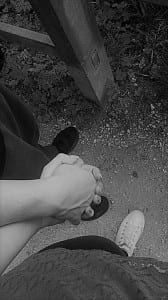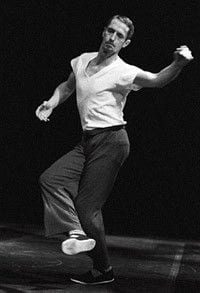Once again I felt that this week was another positive week, I brought more energy and engaged with the tasks effectively. Developing the skills to release the tension in certain parts of the body (specifically the head and neck), was the challenging aspect of this week. I believe this because we hold our heads up everyday without thinking about what we are doing, trying to reverse our natural instincts is more challenging than I contemplated.
 Simone Forti
Simone Forti
Simone Forti is a student and teacher of improvisation, she was involved in the project of Judson Dance Theatre and worked with artists such as Anna Halprin and Merce Cunningham. She has worked on a dance form called Logomotion for 15 years, this explores improvisational dance that is influenced by words occurring when studying common sources.
The two videos studied in the lesson showed how research in Contact Improvisation has developed since the 1970’s, there is a significant iconic change in how we move and the form of Contact Improvisation Steve Paxton developed is not what we practice today. The first video was a showing of one of Paxton’s first performances ‘Magnesium’ (1972), where the improvisers were careless in throwing themselves onto other performers. Movements could be classed as aggressive and abrupt, in saying this there were moments of stillness to create distinction from one ‘lift’ to another whereas in the second video of Blake Nellis and Aaron Brando (Aaron Brando, 2010)movements were continuous. The two improvisers were careful in looking for points of contact that they could explore, they shard equal roles of giving and taking weight. Finally their form of Contact Improvisation was more about trial and error and if something went wrong they developed a way to get out of the movement.
Moving with the head proved to be the most challenging task… especially when partnered with Gemma, this is because I have never worked with her before and we aren’t that aware of each others bodies and personal limitations. I felt that we were repetitive with our movements as we just stood up and released back into a crouch. The other exercise where we held our partners heads was easier, Jess found it difficult to release her head and let me carry all of the weight at first. I think the responsibility of looking after another persons head was uncomfortable personally, I trusted myself that I wouldn’t drop it but the thought made me uneasy. When I had to give the weight of my head to my partner it took me a while to relax, it wasn’t until I closed my eyes that I fully gave her the weight, my movements also changed, I felt more relaxed in the space and I suppose not judged for what I was doing.
The final exercise was ‘Pebbles’, I found this relaxing, giving all of my weight into my partners back was similar to having a massage. The key aspect was to constantly keep contact with my partner, this could only be achieved if I relaxed every part of my body including my head and eyes. Engaging my eyes allowed me to read the situation and understand where I needed to place my body coming off of my partners back. This is mentioned by Daniel Lepkoff in his interview with Simone Forti (2005) ‘Likewise, you need to move your vision to build a sense of where you are in space, you need to take a reading. Once I became aware of this activity of reading space I could allow myself to play with the way I read space, and feel and shape the rhythm of that reading’ (Lepkoff, 2005).
The reading I felt most engaged with was ‘Beginning, Approaching, Practicing, Dancing’ (Paek, S. M, 2015). It talks about the fear of unknown in Contact Improvisation and the questions that go through your head when asked to partner with someone new.
How long will you be working together?
How intimate of frightening will the task be?
Will you feel comfortable?
What will you have to do?
It reminded me of when Kirsty asks us for a partner to demonstrate something and every one goes quiet, we need to just take the opportunity to work with new people and not be afraid of the unknown, committing to what you are doing and being open to create something new with some one you have not worked with before. After all Contact Improvisation requires you to be comfortable with anything and everything that is thrown at you.
Bibliography
Aaron Brando (2010) Contact Improvisation: Blake Nellis & Brando @ Earthdance. Available from https://www.youtube.com/watch?v=zQRF2sLK1vY [Accessed 15 October 2017].
Forti, S. (2005) The Movement of Attention: An interview with Daniel Lepkoff : The Movement Research Performance Journal, 29 (Spring 2005). Available from http://daniellepkoff.com/writings/Daniel%20Simone%20Interview.php [accessed 15 October 2017].
Fronterad (2013) Simone Forti [image]. Available from https://www.bing.com/images/search?q=simone+forti&FORM=HDRSC2 [accessed 15 October 2017].
Paek, S M. (2015) Beginning, Approaching, Practicing, Dancing. Contact Quarterly, Vol 40: 1,pp. 36.
Tumasia (2010) Fall after newton 1 . Available from https://www.youtube.com/watch?v=k768K_OTePM&=&t=300s [accessed 15 October 2017].
Turner, R. (2010) Steve Paxton Interior Techniques: Contact Improvisation and the Political Power. TDR: The Drama Review, 54 (3) 123-135.

